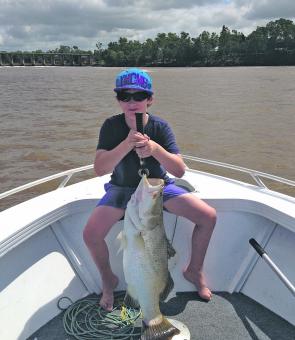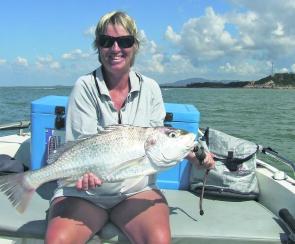The temperatures have been slowly dropping in the past few weeks as we move into winter. Fish like barramundi and mangrove jack have quietened down but other estuary species like salmon, bream, whiting and flathead have increased in quantities.
Big bream are a special in the lower end of the Fitzroy in the cooler months and some of the fish taken recently have been well over the 1kg-mark and several topped 2kg. Port Alma, Mackenzie, Balaclava, Connors, Readys and The Narrows produce XOS bream at any of the rocky oyster beds and myriad structures lining the whole delta area. Flesh baits are the pick down this neck of the woods and mullet is the best as a rule. I still have good success with mullet gut and chook gut the same baits dad used when he chased bream many years ago at the Blue Hole or the Pin.
Everyone of our coastal creeks and headlands hold bream all year spread right through each of the systems. Towards the end of May and into June the smaller schools move towards the mouths of the systems and congregate for winter spawning.
Places like the Causeway Lake, Corio Bay and Coorooman Creek hold large numbers of bream and, like the river, there are loads of oyster rocks and fallen timbers that attract bream on the lower part of the tides while they work the sand and mud bank edges with the incoming tides. There are a lot of yabby beds in the local creeks where you can get all the bait you need at low tide and then fish the same spots as the tide rises. I use the same technique for whiting, flathead, salmon and bream.
Bream are one species that will travel some distance following a berley trail. Finely chop up all your leftover baits from previous trips including pillies, flesh baits and prawns, add this mix to the same amount of bread and mix it well. Freeze it in the old bread bags in handful-sized lumps. I use this mix both inshore or offshore and it works for most fish from mackerel to trevally and tuna and many of the estuary species. These lumps of berley weigh about half a kilo and last around 3-4 hours in a berley pot releasing a slow steady stream, which never seems to fail in getting the attention of the target species.
We get several types of bream up here from yellowfin, black bream and pikey, also called black bream. These guys inhabit the same areas usually but the very large pikey bream stay solo, hanging around a single mangrove root mass until breeding time where they school like the others. When the water is clear you can drift the mangrove banks and see them sitting in the narrow eddy behind the main mangrove trunk. At these times you can sight cast to them and we often nail them with smaller barra lures.
Schools of blue threadfin are travelling along the beaches and creek mouths, especially around the full moon. They hit all the beach gutters and creek mouths at different stages of the tides. Some of the better spots are the mouth of Ross Creek, Coorooman Creek, Corio Bay and Farnborough Beach. At times you can see them in the waves where the white water ends along the deeper channels. In Coorooman the timbers and sand banks out the front can be as good as anywhere with some salmon reaching 3-4kg.
Blues will take pilchards and prawns but live yabbies are very hard to beat anytime. Like I mentioned above, yabby beds are a great spot to find salmon, especially when the beds are close to the creek mouth like Fishing Creek and Ross Creek. A few of the old guys around here target whiting and use the fillets on small gangs to get their salmon. Blue salmon will take shiny lures, flashas and plastics when they are in feeding mode.
Whiting and dart continue in average form along the northern beaches with some quality fish among them. Steelies or flat salmon have gathered for spawning in huge numbers in Coorooman Creek. They are aggressive little fellas and love greenback herrings, prawns and yabbies. I like to target them on very small lures either trolling or casting through eddies and current lines. When you hook a steelback on 1kg line it is great fun as they put on an aerial display fighting well above their class.
Flathead are pretty consistent for much of the year in all the local creeks and the river. Usually you find them in the saltier areas close to the sea, but last week I saw one taken on a lure under the old bridge right in the middle of Rocky. I have seen the odd flatty taken that far up over the years but not on a lure before. Coorooman Creek and Corio Bay are the best places to try and The Causeway is next in line.
Black jew came in again last moon and several of them went more than 26kg. I have only ever seen a couple at that size and one of them was at The Boyne Tannum Hookup this year. The Corio jew hole, The Pinnacles and Manifold were the best options. Pillies and squid are probably the best baits normally except when the lesser mackerels are running, and then doggy fillets stand very high in the rankings.
We must be due for a run of smaller mackerel, especially doggie or Queensland school mackerel. They haven’t reached the expected quantities in recent years inside the bay but the wider spots are still showing schools regularly.
Grey mackerel are another species that has been hit and miss of late although a couple were caught at Findlays and Forty last week. Farnborough, Bangalee and Corio Heads are fairly good spots when the schools travel through the bay.
Spanish mackerel are in good form as reports keep coming in of quality fish at many of the closer spots. They have shown at Barren, Liza Jane and Outer most of this year while Conical and North Keppel have not been in the best form. Bigger tides are the best and the old rule of a high before lunch does the trick for us.
As usual coral trout have continued in numbers around The Keppels, while sweeties, parrot and cod can make a decent feed. Offshore grunter have started taking residence around places such as the Pinnacles, the Rama and Manifold. Just about any of the jew holes will produce good grunter at times. The red fishes are hard to beat at present and it is very hard to come home without at least one legal red emperor in the catch.
The Boyne Tannum Hookup went on this year with the usual success and for me the fishing highlights were a 26kg black jew and a metre-plus released barramundi. It was great to see such support for a comp that clearly benefits the whole community, especially the charities, which receive a share of the proceeds. Well done to the crew once again.
Reads: 2421
Deakin Smithwick with an 86cm barra he landed in the river.

Debbie Reed caught this grunter at Coorooman Creek. This is a popular spot for a variety of species this month.

Debbie Reed with a Coorooman Creek blue salmon. Your best chance of hooking one is around the full moon.




